|
History of Siofok
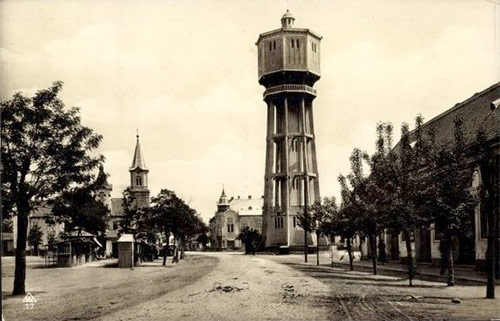
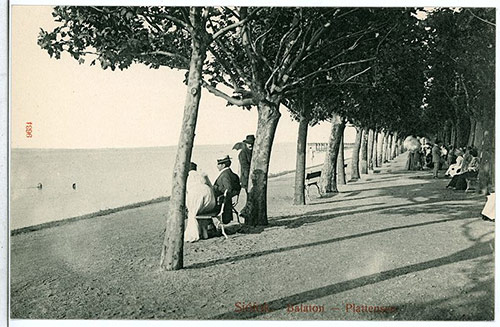
The surroundings of
Siófok was inhabited even in the neolithic period and later,
in Roman times, too. In the material of the Scouting Museum
(1930) established by István Molnár Roman Catholic
chaplaine, one could find even a chipped hyalite collected
by him on the location of Sáfránykert. In his collection
there were hatchets, hoes, milling stones and jewels of the
neolithic period, too. These objects were classified by Dr.
Ferenc Zákonyi, honorary freeman of our town, who was a
town-clerk and an outstanding researcher of the local
history. (Unfortunately, this collection has been destroyed
in the meantime, there are only three photos to witness its
exsistence.)
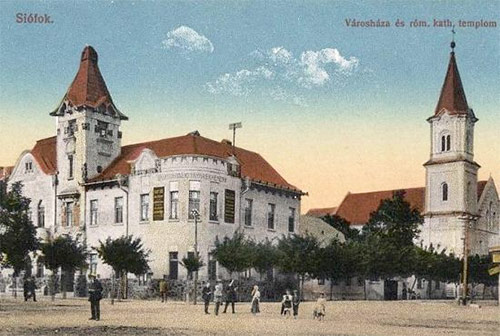
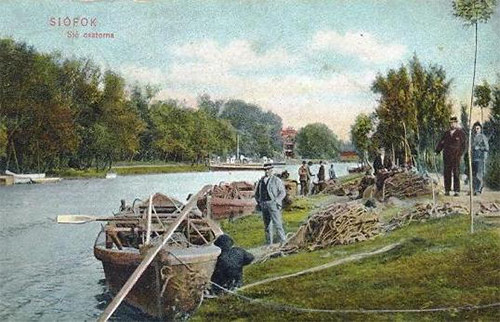
The material from the Copper and the Bronze Age was
preserved by Bálint Kuzsinszky for the succeeding
generations. Sickles, Saw-blades, arms and jewels were found
at Kiliti and in Szigeti baulk. In Vadkacsás baulk of
Széplak 110 urn graves were discovered.
At the Iron Age -at around 350 B.C.- came Celtic people to
this area and it was under their rule that the use of iron
got wide-spread. Traces of a Celtic settlement and silver
coins were found on the eastern edge of Szigeti baulk, close
to the Jewish cemetery. (Dr. Károly Sági archeologist,
Keszthely).
A new chapter started with the Roman occupation in the
history of Trans-Danubia. In order to defend the southern
military roads, establishing the Province of Pannonia, towns
and roads became vitally essential.
Roman conquest got to the surroundings of our present town
of Siófok in the 1st century A.D. and this is the region
where the road from Sopianae (Pécs) lead across Tricciana
(Ságvár) to Arrabona (Gyor). According to the notes made by
Sectus Aurelius Victor in the turn of the 3rd-4th century
Emperor Galerius had a dike built and made some forests
cleared in order to drain the moor-land of "Lacus Pelso" -it
is the Latin name for Balaton- in 292 A.D. He named the
whole region after his wife, Valeria.
One can read in the deed of endowment of Tihany dated 1055,
after the Hungarian conquest, i.e. in the first Hungarian
sporadic literary remains of the language, the following
sentence:
..."Rivulus namque, qui dicitur Fok fluens"....
It means: "The small brook called Fok also springs from the
lake mentioned above and is located where people can go
across an ancient bridge and a ford, too...."
That is to say Fok is not mentioned as a village in the
original deed of endowment despite the fact that the word
"river" refers to the village. (Dr. László Erdélyi:
Questionable deeds of the Abbey of Tihany, HAS, 1909.)
Sources of reference from the 11th-14th centuries mention
seven settlements in the surroundings of our present town of
Siófok, along Fok, or as it is called today Sió: Holovogy,
Losta, Töreki, Kiliti, Fok, Igám and Jód. As to these last
two settlements, only their names have remained in the name
of some baulks or hills.
Based on these descriptions, one can assume that two
settlements might be the same: Holovogy estate close to the
ford in the ancient times and the village of Fok was settled
on the same location later on. The village of Losta was
settled on one of the isles of Siófok, along the brook Fok
in the Age of the Arpads.
The name of the village Fok appears among the tax-paying
settlements first in 1137, while the compound word of Siófok
has been known since 1790.
After the devastations caused by the Mongols Fok was
reconstructed and a parish was also established there. Its
church was consecrated to Peter and Paul. Until the Turkish
conquest it was the district seat of the archdeacon.
In 1541 the Turkish invadors kept moving forward and after
having seized Szigetvár they reached Lake Balaton. In 1552
Veszprém was also occupied and Fok along with its
surroundings got also taken up. Siófok was turned into a
naval port and a fortification was erected here. Besides the
commandant of town two "aghas of the navy" were also resided
here. The Turkish fortification was established near the
present hospital on the "Hill of Granarium". (According to
unwritten tradition, not approved by archeology.)
The country-side was liberated from the Turkish yoke in
1688. Fok got into the possession of the collegiate church
who installed settlers there and in 1693 had a wooden church
built for the inhabitants.
During Rákóczi's fight for freedom Bottyán the Blind's
famous Sió-line stretched here and the final headstone was
the fortification of Siófok. The fortification was
constructed on the location of the fromer Turkish
fortification, according to the French staff engineer, De la
Reviere's project.
In 1705 Ferenc Rákóczi II donated the village of Fok a seal
serving today as a basis for the present coat of arm.
In 1709, after Bottyán's death the "labanc" armies (nickname
of pro-Austrian soldiers during the 18th century Hungarian
wars of independence) managed to capture the settlement.
In 1717, in a contract concluded with the collegiate church
of Veszprém, the inhabitants of Fok managed to get the
lease-holder status.
The parish church of Baroque style consacrated to the
Immaculate Conception of the Blessed Virgin was erected in
1736.
In the course of the 18th century before the blotting paper
came into general use, the fine sand of the shore at Siófok
had been used as writing-sand. Piling up fine quicksand was
the occupation of young girls and wives of Siófok.
The settlement started to develop as of the years of the
1800s. The Transylvania-Adria speed mail coach reached
Siófok as of 1810. (Note: since 1867 an independent
post-office administration and since 1946 a state
post-office has been operating at Siófok).
The 19th century was an important period in the regulation
of water-ways. In 1810 Joseph, the palatine of Hungary
appointed Joseph Beszédes to accomplish the works of
regulating the water-ways of Sárvíz. The works of Sió
Water-system completed between 1810-1825 on the southern
shore of Lake Balaton are as follows:
1. The mill of Fok was pulled down (It burnt down in 1812
and it was not restored any more.)
2. Sió bed was cleaned out.
3. The mills were adjusted.
4. the water-level of Lake Balaton fell one metre thus
51.000 acres of dry land were gained.
5. By regulating Sió brook 6.000 acres of dry land were
gained.
The epidemy of cholera hit the settlement in 1831.
In 1842 the Association for the Regulation of the Balaton
Water was established which buyed and pulled down the mill
and dam of Kiliti, being the biggest obstacles to water
regulation. By the falling water level another 6.000 acres
were gained.
In the life of the settlement an important change was
brought by the foundation of the Steamboating Incorporation
of Balaton under the life presidence of Earl Széchenyi in
compliance with the rules of association made by Lajos
Kossuth in 1846. The paddle-steamer named Kisfaludy was
launched on water on September 21. Ádám Clark and József
Beszédes took part at the ceremony among others.
In the 1850s the area of Siófok having belonged to Somogy
County, got annexed to Veszprém. The border was split by Sió
brook.
In 1858 started the construction of the railway between Buda
and Nagykanizsa which was opened to the public in 1861.
The railway embankment having started in 1858 also
contributed to the stabilization of the southern shore as
filling up the banks of the railway formed a real dam
against the spring inundations. The construction of the
Southern railway started with an extremely low water-level.
It was thought that a bank of 88 cm high would offer safety
against inundation. The higher water levels in the years to
come damaged the banks several times: this is the way how
the "Southern Railway Sociatey" got a leading part in
regulating the lake.
On June 16, 1862, János Michel director on behalf of the
railway offered to accomplish the regulation works with his
own engineers in compliance with the projects of the
Draining Association at the meeting on Füred presided by
Earl Zichy jr., government commissioner. The chancellary
gave instructions even in the same year to construct
Sió-Dike that was opened on October 25, 1863. The plans of
the construction were provided by George Türk, engineer of
Kéthely. The main goal with the dike was to lower the water
level by at least one metre as compared to the minimum level
of December, 1862. (104.096 m A.F. It is the "0" point of
Siófok water measure even today.)
The dike was in operation with larger and smaller
reparations by 1891 when the Board of Agriculture made a
new, iron dike constructed instead of the old, decayed
wooden dike in 1893.
At Siófok the railway station got finished in 1863 and by
1864 the harbour defended by breakwaters was also completed.
The year of 1863 is considered to be the year of birth of
Siófok as a holiday resort.
The year of 1865 is a remarkable anniversary in the history
of Siófok as the settlement of not more than 200 houses and
1500 inhabitants was permitted to make country market thus
it got the rank of market-town.
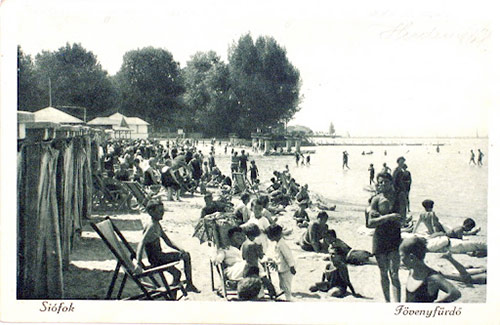
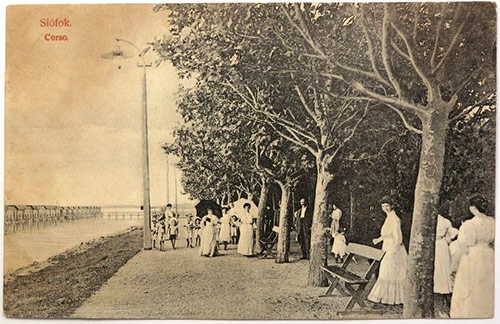
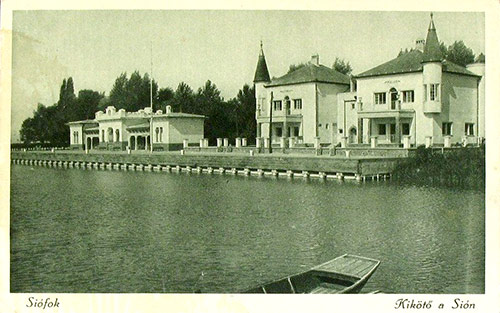
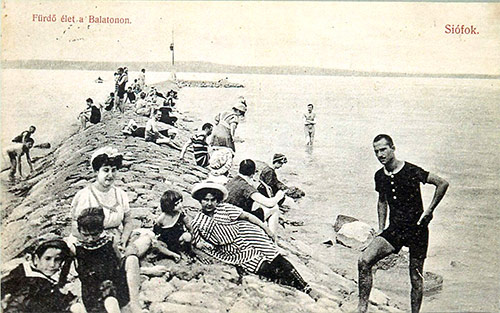
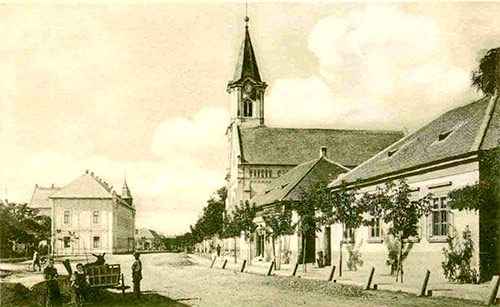
In 1866 was published the first announcement titled "Siófok,
Bathing Resort of Balaton" in Zala-Somogy Gazette. Ignác
Végh leaseholder concluded an agreement with the collegiate
church of Veszprém on a 12-year rent of bathing-place which
was extended for another 12 years.
The Bathing-house titled "Hungarian Sea" was constructed in
1878 according to the plans of Neuschlass constructing
company, in the Swiss style. The bathing-house had a richly
ornamented facade, a parlour for 100 persons, 80
bathing-boxes, a storied belvedere and large windows opening
to the water.
The collegiate church of Veszprém started dividing the
"estates of ebbing" into lots. That is how the present
holiday resort started developing. It marks the fascinating
and inspiring beauty of the landscape that the majority of
the first villa-owners were painters, like Mór Than, Pál
Vágó, Tivadar Feledi-Flesch (Mihály Zichy's son-in-low),
Arthur Tölgyessy.
In 1888 it was Gábor Baross who granted a state loan to the
reorganization of the Steamboating Incorporation of Balaton.
Steamboat Kelén was launched on water in 1889 and renamed
Baross in 1891. Helka and the new Kelén got finished also
that year.
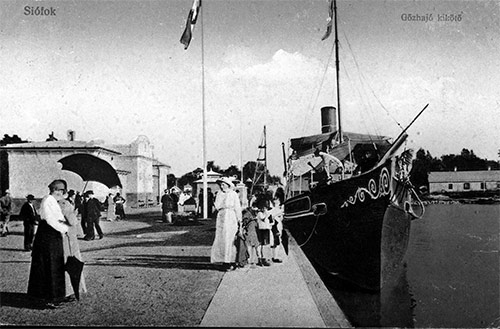
The concern called Siófok, Resort on Balaton established in
April, 1891, bought up the bathing licence from the
collegiate church as well as a 60-acre moorland necessary
for constructing buildings and parks. The soggy and shrubby
land was backfilled with earth. The head of the concern,
Henrik Glatz (1884-1905) was the founder of Franklin
Literature and Press Incorporation.
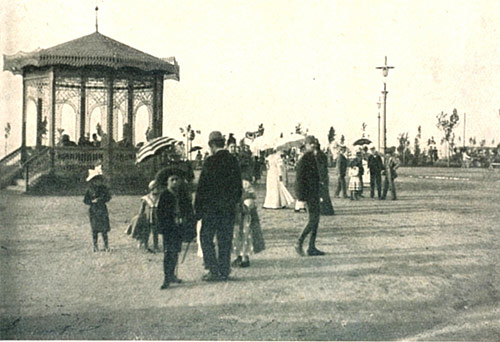
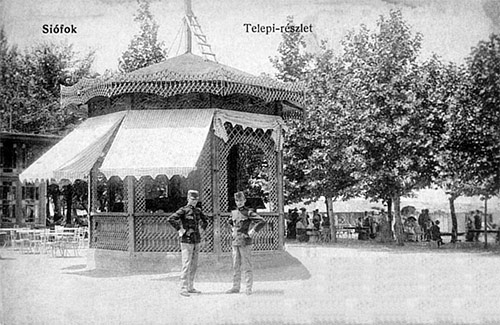
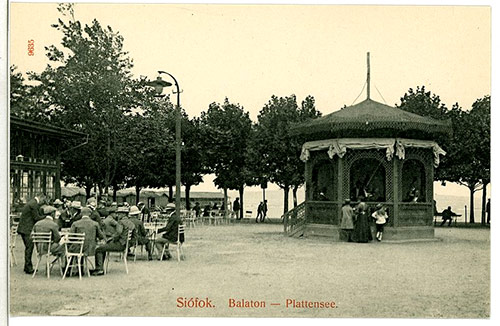
Some major hotels were constructed at that time: Sió and
Hullám and later the Central Hotel. The new resort was
opened with a gala ceremony on July 18, 1893. It was on that
occasion that the Minister of Inner Affairs gave permission
to use the name of "spa". Part of this soothing atmosphere
was the theatre life of Siófok starting in 1875 that
attracted great personalities of the time.
The hyppodrome was constructed in 1900 with its grand-stands
for 1500 people and the targets of the Balaton
cross-swimming race were also set here. The swimming and
tennis concours held each year also added to the richness of
the summer events at Siófok. Due to its busy resort life,
Siófok became a popular spa for artists, actors and the
upper-middle class of Budapest (Karinthy, Krúdy, Latabár).
At the end of the World War II the settlement was badly
damaged. The front-line lasting here for two months
destroyed or damaged a number of buildings, villas, hotels,
family houses, the ship-yard. By destroying the road and
railway bridge it made the reconstruction works extremely
difficult. After 1948 the settlement started to develop in
another direction.
Siófok became the centre for holidays organized by companies
and trade unions. Its reconstructed summer houses, hotels
and the new canalization, sewage system the new water works
have made the site the biggest and most important resort
receiving crowds of people every summer.
Since 1950 the settlement has been belonging to Somogy
County and has become a seat of district rank.
It was in 1955 when the cult of Imre Kálmán started. the
Tourism Office placed a memorial tablet on the house of the
district's great composer.
Tourism started to develop in 1958 since when foreigners
have been returning. In 1962 started the construction of the
hotel line and by the mid-sixties the pride of "Silver
Coast", the Hotel for International Journalists was
completed too. Services meeting with the demands of the site
have also been organized.
On December 29, 1968, Ferenc Jankó, president of the town
committee took over the deed of town rank set forth in the
decision No. 20/1968 NET by the Presidential Council.
The 400-bed hospital was inaugurated. The education started
developing.
The 70s were the years of rapid development. The
construction of the infrastructure of town was almost
finished. The Cultural Centre and the library was opened to
the public in 1976. At the beginning of the 80s the town
started to build up its international relationships and to
improve its connections with fraternal towns.
In 1988 the local paper "Siófok News" was established.
New bridges were built across Sió for the traffic. In 1989
Sió TV started to transmit its programmes. This institute is
the first local television with open transmission.
The "Society for Preserving and Decorating the Town of
Siófok" was given the Water Tower, symbol of town for three
years on the ground-floor of which an exhibition has been
installed.
As a result of the local elections in 1990, an 18-member
board of representatives governed the town. The Mayor was
Árpád Molnár and the Notary was Dr. Tamás Pongor.
The town keeps developing. BALATEL has settled a
long-lasting problem of the inhabitants and visitors by
setting up a new telephone network.
In 1994 as a result of the second local elections a
17-member board of directors started to rule the town. The
Mayor is Dr. Árpád Balázs. From 1995 to 1997 the Notary was
Dr. Ildikó M. Horváth.
Owing to the management profiting well from the endowments
of the site, today it is one of the towns the operation of
which is not threatened, on the contrary, it shows steady
development.
The school network has been enlarged. Besides the basic
requirements, education is also supported: in addition to
the 8 kinder-gardens, 4 elementary schools, 3 secondary
schools and the music school in 1996 the local faculty of
tourism economy of the College János Kodolányi was launched
here.
Today Siófok is one of the most important tourist centre, as
it is said: "Siófok is the capital of Lake Balaton." It has
been made capital by its public transport of high level and
its shallow shore offering safe bathing to holiday-makers.
Besides the mild water of the lake visitors coming here may
enjoy the organized programmes and the Hungarian hospitality
as well.
The town itself is an open-air exhibition with its
sculptures and monuments on public squares. (Among others
one of the greatest Hungarian contemporary sculptor, Imre
Varga who was born at Siófok, exhibited his sculpture of
Imre Kálmán, titled "Vanishing Time".
In addition to the historic buildings,some modern churches
offer an exciting sight by their queer architecture. Due to
the development in recent years the town has become a site
of flowers and parks. An outstanding park in town is the
Millenium Park in front of the railway station.
The town 106 kms far from Budapest can be easily reached by
rail, road or air from every direction.
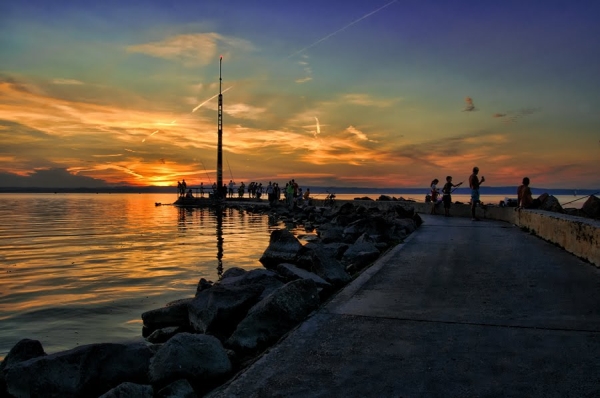
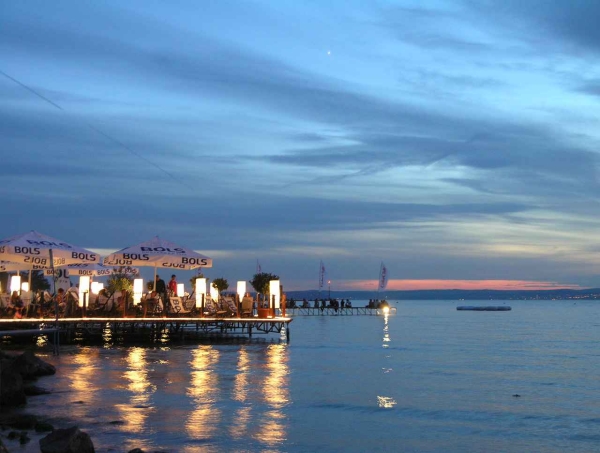
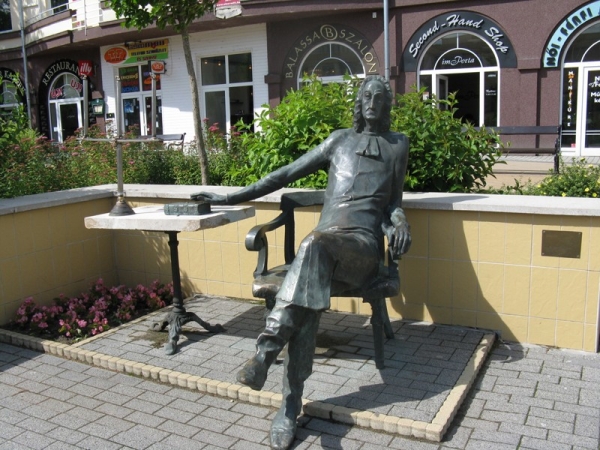
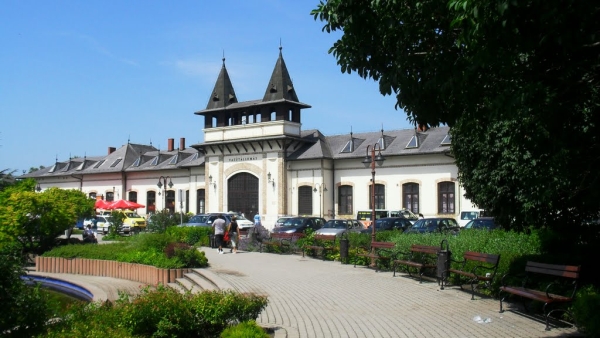
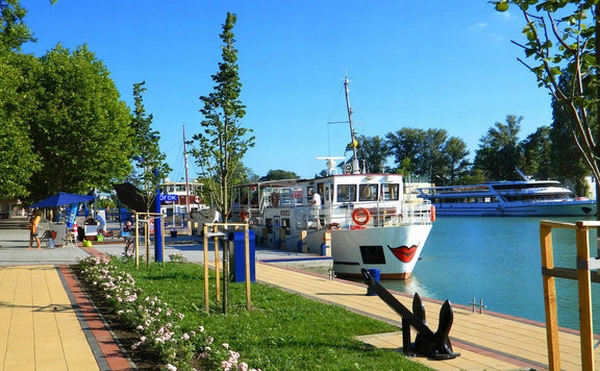
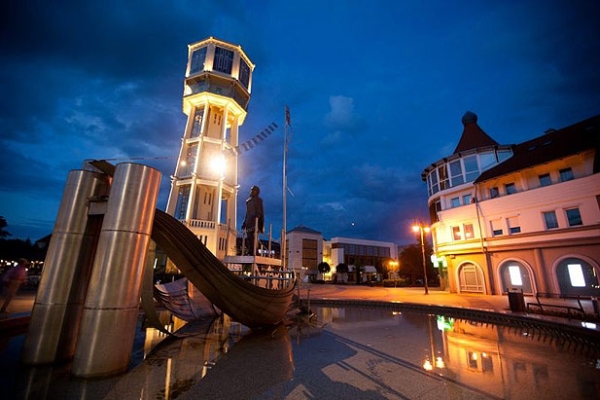
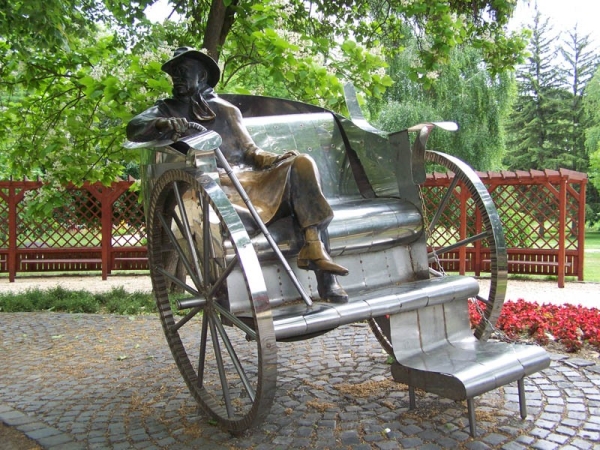
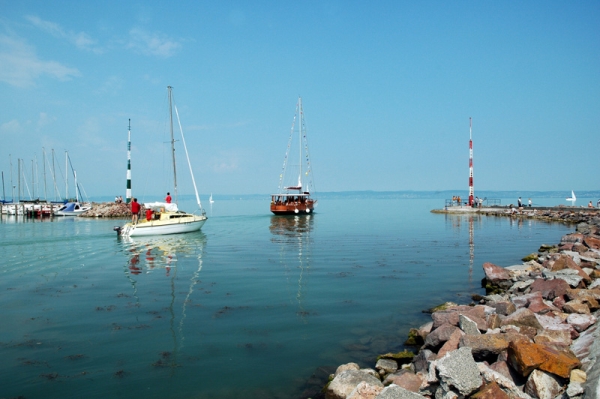
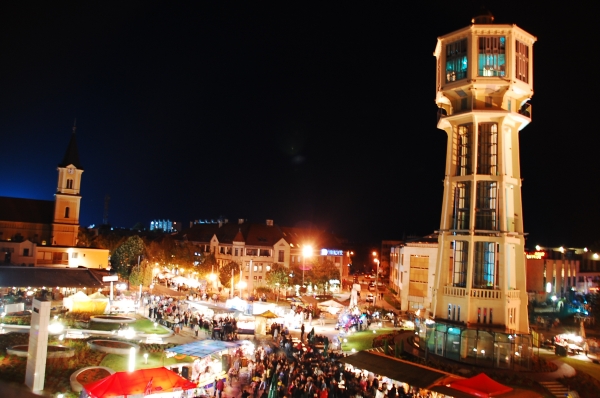
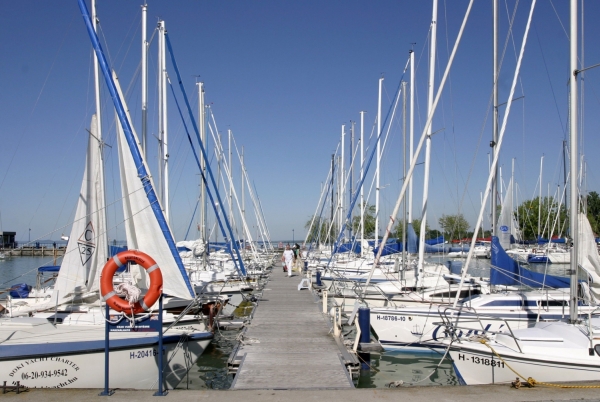
|